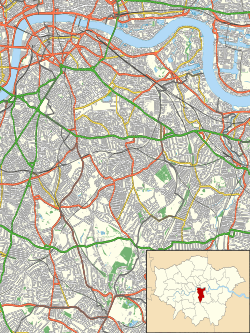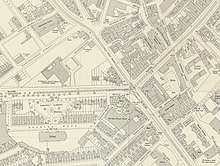Bricklayers Arms
Bricklayers Arms is a road intersection between the A2 and the London Inner Ring Road in Walworth, south London, England. It is the junction of Tower Bridge Road, Old Kent Road, New Kent Road and Great Dover Street and comprises a four-way roundabout with flyover and bypass lane. Eastbound traffic from New Kent Road to Old Kent Road bypasses the roundabout using the flyover and westbound traffic from Old Kent Road to New Kent Road uses the bypass lane.
| Bricklayers Arms | |
|---|---|
_-_geograph.org.uk_-_1766302.jpg) | |

| |
| Location | |
| Southwark, London | |
| Coordinates | 51.49425°N 0.08555°W |
| Roads at junction |
|
| Construction | |
| Type | Roundabout interchange |
| Maintained by | Transport for London |

The junction is named after a local coaching inn that was situated at the junction. It is close to the former site of a large railway facility sharing the same name.
Coaching inn
There have been inns situated at this site for more than six hundred years, and excavations during the rebuilding of the inn in the 1890s came across several previous foundations and a hidden hoard of ancient coins.[1] It was the point at which coaches travelling along the Old Kent Road to or from the City of London set down or picked up passengers travelling to or from the West End.[2] The inn was situated on land owned by the City of London Corporation, and its sign was the coat of arms of the Worshipful Company of Tylers and Bricklayers.
Roundabout and Flyover

Approval of plans for construction of the roundabout and flyover to replace the junction of the Old Kent Road (A2), New Kent Road (A201) and Tower Bridge Road (A100) was given by the London County Council in December 1962 with an initial budget cost of £3,510,000. Works were planned to start in 1967.[3] Construction of the roundabout and flyover involved the demolition of buildings in all three roads and the surrounding area as part of a larger regeneration programme of works. The first section of Old Kent Road between Great Dover Street and the junction with New Kent Road lies under the roundabout or has been renamed as part of Great Dover Street.
In the 1970s there was a plan by the Greater London Council for a road to go between the Bricklayers Arms roundabout and the northern entrance of the Blackwall Tunnel, crossing the Thames in two tunnels (one adjacent to Tower Bridge) and providing a link to London Docklands.[4]
The rather over-generous proportions of the roundabout, which included pedestrian underpasses from the adjacent roads onto it, were a result of London Underground safeguarding a route for a possible future extension of the Bakerloo line from its terminus at Elephant & Castle tube station. This was to run along and under the main road and hence, underneath the trackways of the old mainline station, to join surface services at South Bermondsey station. The roundabout would have been the site of a station, similar in layout to Old Street station. The route is still safeguarded but has no prominence in current proposals. The pedestrian underpasses were not attractive and involved quite circuitous walks via the island, surfacing and descending again to the various entrances. In 2009, these were supplemented by pelican crossings at the junctions with New Kent and Old Kent Roads, introduced because pedestrians preferring to cross there were causing more accidents. In 2013 the underpasses were filled in and levelled, becoming wider pavements.
Notes
- Arnold 1898, p. 283.
- Nock 1961, p. 26.
- "£3m Traffic Plan for Old Kent Road". The Times (55568): 7. 7 December 1962. Retrieved 18 March 2019.
- "The Pool of London Road". SE1 Community Newsletter. London: London SE1 Website. June 1979. Retrieved 13 May 2014.
References
- Arnold, Lester (29 January 1898). "Where rare coins come from". The Boy's Own Paper (994).CS1 maint: ref=harv (link)
- Nock, O.S. (1961). The South Eastern and Chatham Railway. London: Ian Allan.CS1 maint: ref=harv (link)
External links
| Wikimedia Commons has media related to Bricklayers Arms. |